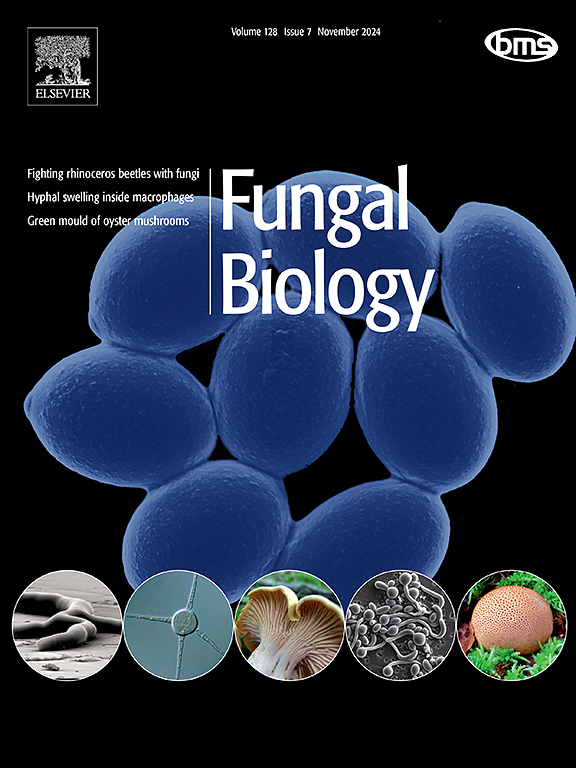Resistance evolution and local adaptation of Venturia inaequalis to old and new generation SDHI fungicides
IF 3
3区 生物学
Q2 MYCOLOGY
引用次数: 0
Abstract
The use of succinate dehydrogenase inhibitor (SDHI) fungicides is widespread in controlling apple scab disease caused by Venturia inaequalis. However, resistance in populations develops and new SDHIs are generated commercially, thus evaluating this arms-race in local populations is important for appropriate disease management. In this study, in vitro mycelial growth effects of five commercial fungicides, including old and new generation SDHIs on a large V. inaequalis population in Türkiye were investigated. Overall, the entire population was resistant to Boscalid (Cantus®), and the most effective fungicides tested were Isopyrazam (REFLECT®) and Pydiflumetofen (Candidate fungicide, Miravis®). Although the results show the effectiveness of new generation SDHIs, remarkable differences in pathogen resistance responses were detected at local level. There were also differences in colony growth rates among isolates, but this was not associated with fungicide response traits. Furthermore, the intraspecies genetic diversities obtained from the sequence data of the four selected gene regions were depicted with the Neigbour_Joining (NJ) trees. There appeared to be no relationship between NJ-based branching and fungicide response phenotypes. As a result of mating type determinationof the isolates with newly designed primers, 1:1 ratio indicated possible recombination in almost all local groups, with one exception. Additionally, detection of both mating type genes in some isolates was an interesting finding about the reproductive structure of the pathogen. This study, which is the first comprehensive study of V. inaequalis in Türkiye, presents new findings about the pathogen from different perspectives.

不均等文氏菌对新、老一代SDHI杀菌剂的抗性进化及局部适应
琥珀酸脱氢酶抑制剂(SDHI)杀菌剂广泛应用于防治苹果黄斑虫病。然而,人群中出现耐药性,新的SDHIs在商业上产生,因此评估当地人群中的这种军备竞赛对于适当的疾病管理很重要。本研究研究了5种商用杀菌剂(包括新一代和旧一代SDHIs)对大蠊种群的体外菌丝生长的影响。总体而言,整个种群对Boscalid (Cantus®)具有耐药性,测试的最有效的杀菌剂是异吡嗪(REFLECT®)和吡氟醚(候选杀菌剂Miravis®)。虽然结果显示新一代SDHIs的有效性,但在地方水平上发现了显著的病原菌耐药反应差异。菌株间菌落生长速率也存在差异,但这与杀菌剂反应特性无关。此外,利用4个选择的基因区序列数据,用Neigbour_Joining (NJ)树描述了种内遗传多样性。nj基分支与杀菌剂反应表型之间似乎没有关系。用新设计的引物对分离物进行交配类型测定,结果表明,除了一个例外,在几乎所有的局部群体中,1:1的比例表明可能存在重组。此外,在一些分离株中检测到两种交配型基因是关于病原体生殖结构的有趣发现。本研究首次全面研究了基耶病毒中不均等弧菌,从不同的角度对病原菌进行了新的研究。
本文章由计算机程序翻译,如有差异,请以英文原文为准。
求助全文
约1分钟内获得全文
求助全文
来源期刊

Fungal biology
MYCOLOGY-
CiteScore
5.80
自引率
4.00%
发文量
80
审稿时长
49 days
期刊介绍:
Fungal Biology publishes original contributions in all fields of basic and applied research involving fungi and fungus-like organisms (including oomycetes and slime moulds). Areas of investigation include biodeterioration, biotechnology, cell and developmental biology, ecology, evolution, genetics, geomycology, medical mycology, mutualistic interactions (including lichens and mycorrhizas), physiology, plant pathology, secondary metabolites, and taxonomy and systematics. Submissions on experimental methods are also welcomed. Priority is given to contributions likely to be of interest to a wide international audience.
 求助内容:
求助内容: 应助结果提醒方式:
应助结果提醒方式:


